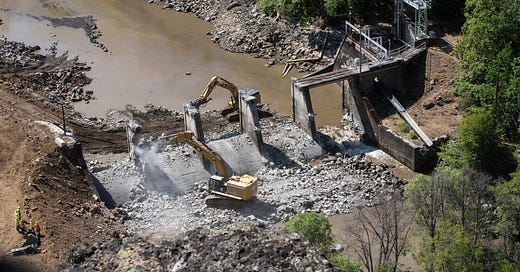Removing dams restores fish, river ecologies, and much more
The Klamath and other rivers now flow freely without dams
On Wednesday, August 28, workers breached the last major dams on the Klamath River, freeing the major section of the waterway—over 200 miles—of obstruction and allowing for the unimpeded flow of the river for the first time in over 100 years. Except for two small dams remaining in the headwaters, the river is restored to its pre-twentieth century flow.
Long ago, the Klamath had been home to and spawning grounds for millions of salmon. Starting in 1918, however, power companies constructed hydroelectric dams along the river’s course, presenting obvious obstacles for the fish. The manmade lakes behind the dams also occasionally created toxic conditions for the salmon, leading to large die-offs. Over decades, the population of salmon in the Klamath dwindled.
Conservationists, Native Americans of the region, and others hope the restoration of the natural flow of water to the Klamath will return salmon to their historic numbers. They have reason to hope. And they also have reason to believe that more than the salmon will be restored.
In 2014, removal of two large dams in Washington State’s Olympic Peninsula restored the Elwa River to its original hydrological flow. Within two and a half years, salmon and other fish—chinook, coho, sockeye, pink salmon, chum, winter steelhead, summer steelhead, Pacific lamprey, and bull trout—returned upstream, past where the first dam had been, and almost all of the fish returned to waters past the second dam within five years.
The Elwa River restoration has also benefited local beaver populations by expanding the riparian zone of the river and increasing the beavers’ food supply. Being “ecosystem engineers,” beavers benefit riparian ecologies by aiding the storage of groundwater and creating wetlands.
There is more good news. Normally, silt and sand are carried to a river’s mouth to replenish estuaries and beaches. But dams capture that sand and silt in their lakes and reservoirs, which ultimately leads to or exacerbates coastal erosion. Scientists found that restoring the Elwa’s waterway has reversed coastal erosion around the mouth of the river, which is west of Port Angeles, Washington. Scientists are also studying the river’s estuary and its response to the increased sediment after the dam removals. Evidence from a dam removal in Taiwan indicates that populations of large invertebrates living downstream, such as crayfish, suffered after dam removal, but this may be only a temporary condition until sedimentation in the stream returns to a more natural condition.
The U.S. is slowly removing dams from our waterways. Last year, conservation and restorations efforts removed 65 dams, mostly in Ohio, Pennsylvania, and Virginia. This may seem like a lot, but there are tens of thousands of dams across the U.S. Removing dams restores rivers, but aging dams are also part of this country’s problem of aging infrastructure. Communities and peoples’ lives are endangered by more than 2,200 aged dams across the country, according to a recent Associated Press analysis. And that analysis may be greatly underestimating the figure as some states don’t keep track of such information and many federal agencies refuse to release records on this problem.
Europe is outpacing the U.S. in dam removal. In 2022, 325 dams, weirs, and other impoundments were removed from European rivers. One surprising dam removal took place in war-torn Ukraine: a 120-year-old dam was removed from the Perkalaba River in the Carpathian Mountains. About 15 miles of river were restored, enabling fish, including the endangered Danube salmon, to reach their traditional spawning grounds. Similar to other restoration efforts, the returning fish are hoped to benefit other creatures, such as brown bears, otters, and European minks.
Even the removal of small dams can have a beneficial effect on the environment as the dams can have a more profound effect than their size might indicate. For example, agriculture and ranching have expanded in the Cerrado, a savannah ecoregion in southern Brazil. To impound water for their cattle, farmers build dams, which are usually small to create ponds and lakes that are less than three-quarters of an acre in size. Despite the dams’ small size, a group of scientists from Brazilian universities found that they affected the environment, reducing the numbers of dragonflies, damselflies, and other aquatic insects in and around areas where these dams have been constructed. This finding is significant. The damselflies and dragonflies prey on other insects and are themselves food for birds, such as kestrels and merlins. Their lower populations most likely indicate changes to the larger ecology of the Cerrado.
In a few days, I’ll be publishing a follow-up to this Green Dispatch featuring many maps displaying dams, their status, their uses, such as fisheries or hydroelectric power, and other information on dams. This special publication is for paid subscribers only. So if you’d like to receive this exclusive edition of The Green Dispatch, upgrade to a paid subscription now by clicking the button below.
X (You can find me on that thing formerly known as Twitter.)
And if you’re going to have a reservoir, you’re going to have Reservoir Dogs.






I love these dam removal stories of habitat restoration. They give m hope that we can reverse so many other insults to nature.
Thanks for highlighting this initiative to restore free flowing rivers in the west. Obviously communities may lose carbon-free electricity, flood control, irrigation or recreation in the process of dam removal. But with the growth in other clean energy sources, we should be looking for more opportunities to rewild our rivers to restore cultural and natural resources.
Here in Chicago, where our namesake river has been abused and channelized for nearly 200 years, we have made progress. Not only was the city’s only dam removed recently, but the world’s first floating eco park is growing on a former industrial canal. Connecting more residents to our rivers will help raise awareness of their role in protecting this critical habitat.